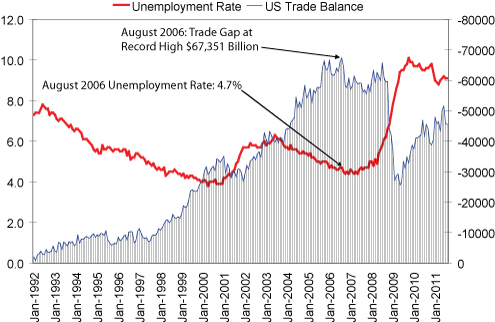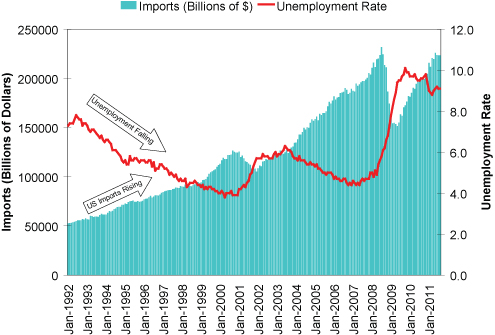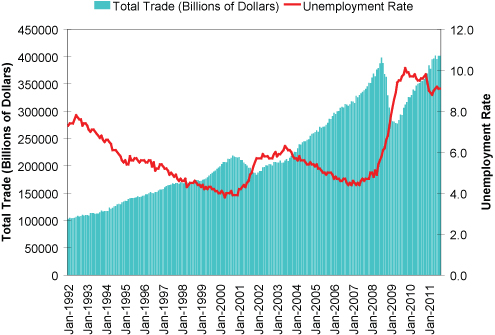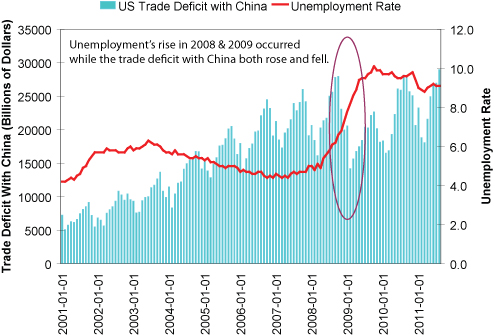Personal Wealth Management /
That (Non-Existent) Giant Sucking Sound
Many suppose foreign trade reduces employment opportunities for American workers. But digging even slightly below the surface showsthese theories lack factual support.
A “giant sucking sound.” That was how erstwhile politician Ross Perot described foreign trade as it applied to the North American Free Trade Agreement (NAFTA) during 1992’s presidential campaign. The theory: International trade, and the resulting US trade deficit, would rob America of jobs. And that’s a popular theme in discussion of free trade even to this day: The often-repeated mantra country such-and-such is “stealing American jobs.”
Never mind for a moment that vacuum noise never materialized as American unemployment fell in the 1990s—following NAFTA’s enactment—to a sub-4% rate by 2000. And a similar feat was repeated in the mid-2000s, with unemployment hitting 4.4% by 2007. Those facts don’t stop rhetoric invoking trade’s supposed negative impact on American jobs. And that’s rhetoric likely to resurface in 2012’s election season.
While there are certainly folks whose jobs are outsourced or lost to competition, the scale of this is rarely referenced in any provable sense. But when assessing unemployment and trade, it’s easy enough to see increased trade does not drive a higher unemployment rate. In fact, as trade rises historically, unemployment falls. Here are three charts to illustrate the point.
Exhibit 1 shows the US trade balance (inverted) plotted against the US unemployment rate. As the trade deficit rises (blue) note unemployment (red) falls. So the theory an increasing trade deficit leads to higher unemployment is not supported by historical data.
Exhibit 1: Trade Balance (Inverted) Versus Unemployment
Source: US Bureau of Labor Statistics, US Census Bureau.
Part of the reason for this is the trade deficit is, in our view, a bizarre way to measure international trade. Let’s look at this differently. Exhibit 2 shows US imports (blue) and the US unemployment rate (red). Here, too, the pattern is unmistakable—rising imports do not drive a higher unemployment rate. However, when imports dropped sharply in 2008, the unemployment rate correspondingly rose.
Exhibit 2: US Imports (Billions of Dollars) Versus Unemployment
Source: US Bureau of Labor Statistics, US Census Bureau.
Lastly, here’s a third look—this one at total trade (exports plus imports) versus unemployment. As shown, falling total trade seems to coincide with rising unemployment—not the other way around.
Exhibit 3: US Total Trade Versus Unemployment
Source: US Bureau of Labor Statistics, US Census Bureau.
If the theory rising imports or foreign competition causes a major loss of American jobs were true, some sign should appear in the above. It doesn’t.
So what is the scale of jobs lost related to outsourcing or foreign competition? Staffing consultancy Challenger, Gray and Christmas (CGC) has some interesting data regarding the former.
Outsourcing, by definition, is a corporate plan to shift jobs abroad. So CGC’s planned layoff report should provide at least a decent barometer to help size up outsourcing in general. And in fact, their monthly planned layoff report has a separate line item for outsourcing in the “layoff cause” section. In the 12 months ending in September 2011, CGC data show 3,555 layoffs due to outsourcing out of 634,916 planned job cuts for any reason. That’s awfully hard to match with rhetoric claiming American companies are, en masse, shipping jobs overseas. Maybe you quibble with CGC’s data and think offshoring figures are higher. Fair enough—I’m open to the concept these figures understate the phenomenon. But how much higher? Many (highly politicized) analyses ignore the longstanding trend of productivity gains—thus massively overstating outsourcing. And as to whatever number of jobs are lost, are they not being replaced over time by new, different jobs, perhaps in the same or other industries? The charts above would seemingly indicate history shows little negative influence.
Moreover, the Organization for International Investment (OFII) also points out the very infrequently referenced opposite exists—insourcing. (So infrequently referenced in fact, that while Microsoft Word’s spell check recognizes outsourcing, it doesn’t recognize insourcing.) Yes, believe it or not, foreign companies do have subsidiaries in the US, and they do hire Americans. In fact, as of 2010’s close, OFII reports 5.3 million Americans are employed directly by foreign companies—a total payroll of $408.5 billion. The average income is $73,023—33% higher than average employee compensation for US-based firms. Not lousy jobs. And while some believe foreign trade is negatively impacting American manufacturing (wrong, as my editor Lara Hoffmans illustrates here), the fact is 38% of the jobs alluded to above are in manufacturing—a greater share than manufacturing represents in the US workforce at large. And in OFII’s recent report on entirely new projects—greenfield investments—made by foreigners, they find foreign companies invested over $25 billion in 748 projects in 2011’s first half—creating an estimated 55,484 American jobs.
Clearly, outsourcing isn’t the only force discussed as it pertains to trade and employment. Many folks claim competition is the real issue, and countries (mostly China) with an undervalued currency have an unfair competitive advantage negatively impacting American business, and thus, jobs.
If a Chinese product reaches American shores, yes, it had to be produced. But, as Frederic Bastiat might say, that is the seen effect. The unseen effect, discussed broadly here by researchers at the Federal Reserve Bank of San Francisco, is the majority of the money these products reap remains in the United States. The same product has to be transported, loaded and unloaded at ports, delivered to stores, marketed and sold. And if it’s a durable item, it may later have to be serviced. If it’s an intermediary good (the majority of US imports are), then it’s used in the final assembly of, frequently, a US business’s product. There are plenty of jobs associated with all those roles. Thus, imports—no matter their source—do not hamper employment.
Exhibit 4 plots the US’s trade deficit with China since its 2001 entry into the World Trade Organization against the unemployment rate.
Exhibit 4: US Trade Deficit with China Versus Unemployment
Source: US Bureau of Labor Statistics, US Census Bureau.
As shown, during the mid-2000s, the US’s trade deficit with China grew. Unemployment fell. In 2008, the trade deficit with China increased while unemployment grew, then decreased while unemployment grew—seemingly indicating then-rising unemployment was unrelated to trade with China.
History seems to show the US’s trade deficit with China—or anyone else for that matter—is not a significant or even meaningful influence in driving unemployment higher. In fact, if reviewing the data from the 2000s (including during the recovery from 2008-2009’s recession), one might conclude it helped drive employment higher.
Ultimately, foreign trade has been scapegoated as having a negative impact on employment levels for generations. But all in all, what drives unemployment higher is recession—plain and simple. Time and growth are what bring unemployment down, and foreign trade—of all kinds—is beneficial to the growth side of that equation. Free trade is unlikely to immediately and directly result in many more jobs, just as it doesn’t directly result in far fewer. But allowing capital, goods and services to flow unfettered where they’re most efficiently used does improve economic conditions for all parties involved. Thus, fear of foreign trade’s influence on employment is a bigger risk to the US economy—and hence, employment—than foreign trade itself.
If you would like to contact the editors responsible for this article, please message MarketMinder directly.
*The content contained in this article represents only the opinions and viewpoints of the Fisher Investments editorial staff.
Get a weekly roundup of our market insights
Sign up for our weekly e-mail newsletter.

You Imagine Your Future. We Help You Get There.
Are you ready to start your journey to a better financial future?

Where Might the Market Go Next?
Confidently tackle the market’s ups and downs with independent research and analysis that tells you where we think stocks are headed—and why.









